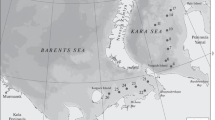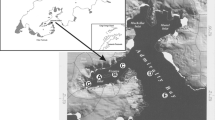Summary
During the autumn of 1987 a survey was carried out in the Atlantic sector of the Southern Ocean in order to study phytoplankton community structure in relation to hydrological features. The positions of the boundary zones, determined by means of hydrological and chemical properties (especially silicic acid) match with previous studies. The phytoplankton community structure was studied by means of algal pigment fingerprints. A cluster analysis of the main phytoplankton pigments revealed the presence of four distinctive phytoplankton communities in the area. In three cluster groups phytoflagellate pigments of different taxonomical groups were found which showed different relative abundance between the cluster groups. In between the Polar Front Zone and the Weddell Scotia Confluence a fourth group was found which was rich in diatoms as compared to the other cluster groups. High concentrations of the fucoxanthin related 19′-hexanoyloxyfucoxanthin indicated the relative importance of Prymnesiophyceae during fall in this area. The relative contribution of each taxonomical group to total phytoplankton biomass was estimated by using specific pigment ratios. This calculation showed that in this time of the year phytoflagellate biomass (especially Prymnesiophytes) surpasses diatom biomass.
Similar content being viewed by others
References
Arpin N, Svec WA, Liaaen-Jensen S (1976) New fucoxanthin-related carotenoids from Coccolithus huxleyi. Phytochemistry 15: 529–532
Bennekom AJ, von Berger GW, Gaast SJ, van der Vries RTP de (1988) Primary productivity and the silica cycle in the Southern Ocean (Atlantic Sector). Palaeogeogr Palaeoclim Palaeoecol 67:19–30
Bidigare RR, Frank TJ, Zastrow C, Brooks JM (1986) The distribution of algal chlorophylls and their degradation products in the Southern Ocean. Deep-Sea Res 33:923–937
Bidigare RR, Marra J, Dickey TD, Iturriaga R, Baker KS, Smith RC, Pak H (1990) Evidence for phytoplankton succession and chromatic adaptation in the Sargasso Sea during spring 1985. Mar Ecol Prog Ser 60:113–122
Bjørnland T, Guillard RRL, Liaaen-Jensen S (1988) Phaeocystis sp. clone 677–3-Atropical marine planctonic Prymnesiophyte with fucoxanthin and 19′-acyloxyfucoxanthins as chemosystematic carotenoid markers. Biochem Syst Ecol 16:445–452
Bodungen B, von Smetacek VS, Tilzer MM, Zeitschel B (1986) Primary production and sedimentation during spring in the Antarctic Peninsula region. Deep-Sea Res 33:177–194
Broeckel K von (1981) The importance of nanoplankton within the pelagic ecosystem. Kieler Meeresforsch 5:61–67
Buck KR, Garrison DL (1983) Protists from the ice-edge region of the Weddell Sea. Deep-Sea Res 30:1261–1277
Buma AGJ, Bano N, Veldhuis MJW. Comparison of the pigmentation of two ecotypes of Phaeocyslis of pouchetu during growth in batch cultures (in press)
Burkholder PR, Sieburth JM (1961) Phytoplankton and chlorophyll in the Gerlache and Bransfield Straits of Antarctica. Limnol Oceanogr 6:45–52
Campbell L, Carpenter EJ, Ianoco J (1983) Identification and enumeration of marine chroococcoid Cyanobacteria by immunofluorescence. Appl Environ Microbiol 46:553–559
Carreto JI, Catoggio JA (1976) Variations in pigment contents of the diatom Phaeodactylum tricornutum during growth. Mar Biol 36:105–112
Cederløf UEB, Bennekom AJ, von Veth C (submitted) On the exchange of water masses across the Weddell Scotia Confluence area.
Coats DW, Harding LW Jr (1988) Effect of light history on the ultrastructure and physiology of Prorocentrum mariae-lebouriae. J Phycol 24:67–77
Davis JC (1973) Statistics and data analysis is geology. Wiley and Sons, NY
El-Sayed SZ (1988) Seasonal and interannual variabilities in Antarctic phytoplankton with reference to krill distribution. In: Sahrhage D (ed) Springer, Antarctic Ocean and resources variability. Berlin Heidelberg, pp 101–119
El-Sayed SZ, Biggs DC, Holm-Hansen O (1983) Phytoplankton standing crop, primary production and near-surface nitrigenous nutrient fields in the Ross Sea, Antarctica. Deep-Sea Res 30:871–886
Fawley MW (1989) Detection of chlorophyll c 1, c 2 and c 3 in pigment extracts of Prymnesium parvum (Prymnesiophyceae). J Phycol 25:601–604
Foster TD (1984) The marine environment. In: Laws RM (ed) Antarctic ecology. Br Antarct Survey, Acad Press 2:357–370
Gallagher JC, Alberte RS (1985) Photosynthetic and cellular photoadaptive characteristics of three ecotypes of the marine diatom Sceletonema costatum (Grev.) Cleve. J Exp Mar Biol Ecol 94:233–250
Garrison DL, Buck KR (1985) Sea-ice communities in the Weddell Sea:Species composition in ice and plankton assemblages. In: Gray JS, Christiansen ME (eds) Marine biology of polar regions and effects of stress on marine organisms. Wiley and Sons, pp 103–122
Garrison DL, Buck KR, Fryxell GA (1987) Algal assemblages in Antarctic pack ice and in ice-edge plankton. J Phycol 23:564–572
Gieskes WWC, Elbraechter M (1986) Abundance of nanoplankton-size chlorophyll-containing particles caused by diatom disruption in surface waters of the Southern Ocean (Antarctic Peninsula region). Neth J Sea Res 20:291–303
Gieskes WWC, Kraay GW (1983) Dominance of Cryptophyceae during the phytoplankton spring bloom in the central North Sea detected by HPLC analysis of pigments. Mar Biol 75:179–185
Gieskes WWC, Kraay GW (1986a) Analysis of phytoplankton pigments by HPLC before, during and after mass occurrence of the microflagellate Corymbellus aureus during the spring bloom in the open North Sea. Mar Biol 92:45–52
Gieskes WWC, Kraay GW (1986b) Floristic and physiological differences between the shallow and the deep nanoplankton community in the euphotic zone of the open tropical Atlantic revealed by HPLC analysis of pigments. Mar Biol 91:567–576
Gieskes WWC, Kraay GW, Nontji, A, Setiapermana D, Sutomo (1988) Monsoonal alteration of a mixed and a layered structure in te phytoplankton of the euphotic zone of the Banda Sea (Indonesia): A mathematical analysis of algal pigment fingerprints. Neth J Sea Res 22:123–137
Gordon AL (1967) Structure of Antarctic waters between 20°W and 170°W. Antarct Map Folio Ser, Folio 6, Am Geogr Soc, 10 pp
Gordon AL (1988) Spatial and temporal variability within the Southern Ocean. In: Sahrhage D (ed) Antarctic oceans and resources variability. Springer, Berlin Heidelberg pp 41–56
Guillard RRL, Kilham P (1977) The ecology of marine planctonic diatoms. In: The biology of diatoms. Werner D (ed) Univ Calif Press, pp 372–469
Hart (1942) Phytoplankton periodicity in Antarctic surface waters. Discovery Rep 21:261–365
Haxo FT (1985) Photosynthetic action spectrum of the coccolithophorid Emiliania huxleyi (Haptophyceae): 19′-hexanoyloxyfucoxanthin as antenna pigment. J Phycol 21:282–287
Hayes PF, Whitaker TM, Fogg GE (1984) The distribution and nutrient status of phytoplankton in the Southern Ocean between 20° and 70°W. Polar Biol 3:153–165
Hertzberg S, Mortensen T, Birch G, Siegelman HW, Liaaen-Jensen S (1977) On the absolute configuration of 19′-hexanoyloxyfucoxanthin. Phytochemistry 16:587–590
Hewes CD, Holm-Hansen O, Sakshaug E (1985) Alternate carbon pathways at low trophic levels in the Antarctic food web. In: Siegfried WR (ed) Antarctic nutrient cycles and food webs. pp. 277–283
eywood RB, Whitaker TM (1984) The Antarctic marine flora. In: Laws RM (ed) Antarctic ecology Br Antarct Survey, Acad Press 2:373–419
Hooks CE, Bidigare RR, Keller MD, Guillard RRL (1988) Coccoid eukaryotic marine ultraplankters with four different HPLC pigment signatures. J Phycol 24:571–580
Jacques G (1989) Primary production in the open Antarctic ocean during the austral summer. A review. Vie Milieu 39:1–17
Jeffrey SW (1974) Profiles of photosynthetic pigments in the ocean using thin-layer chromatography. Mar Biol 26:101–110
Jeffrey SW (1976) A report of green algal pigments in the central North Pacific Ocean. Mar Biol 37:33–37
Jeffrey SW, Sielicki M, Haxo FT (1975) Chloroplast pigment patterns in dinoflagellates. J Phycol 11:374–384
Jeffrey SW, Wright (1987) A new spectrally distinct component in preparations of chlorophyll c from the microalgae Emiliania huxleyi (Prymnesiophyceae). Biochim Biophys Acta 894:180–188
Kana TM, Glibert PM, Goericke R, Welschmeyer NA (1988) Zeaxanthin and b-carotene in Synechococcus WH7803 respond differently to irradiance. Limnol Oceanogr 33:1623–1627
Klein B (1988) Variations in pigment content in two benthic diatoms during growth in batch cultures. J Exp Mar Biol Ecol 115: 237–248
Marchant HJ, Buck KR, Garrison DL, Thomsen HA (1989) Mantoniella in Antarctic waters including the discription of M. antarctica sp. nov. (Prasinophyceae). J Phycol 25:167–174
Michel RL (1984) Oceanographic structure of the eastern Scotia Sea II. Chemical oceanography. Deep-Sea Res 31:1157–1168
Neveux J (1976) Dosage de la chlorophyll-a et de la phaeophytine par fluorometrie. Anal Inst Oceanogr 52:165–174
Patterson SL, Sievers HA (1980) The Weddell Scotia confluence. J Phys Oceanogr 10:1584–1610
Priddle J, Heywood RB, Theriot E (1986) Some environmental factors influencing phytoplankton in the Southern Ocean around South Georgia. Polar Biol 5:65–79
Riley JP, Wilson TRS (1967) The pigments of some marine phytoplankton species. J Mar Biol Assoc UK 47:351–362
Shapiro LP, Haugen EM, Keller MD, Bidigare RR, Campbell L, Guillard RRL (1989) Taxonomic affinities of marine coccoid ultraphytoplankton: a comparison of immunochemical surface antigen cross-reactions and HPLC chloroplast pigment signatures. J Phycol 25:794–797
Sieburth JM (1959) Antibacterial activity of Antarctic marine phytoplankton. Limnol Oceanogr 4:419–424
Sievers HA, Nowlin WD Jr (1988) Upper ocean characteristics in Drake passage and adjoining areas of the Southern Ocean, 39°W–95°W. In: Sahrhage D (ed) Antarctic Ocean and resources variability. Springer, Berlin Heidelberg, pp 57–80
Smetacek V, Veth C (1989) Summary review of EPOS leg 2. Ber Polarforsch, Rep Polar Res 65:2–9
Thomsen HA, Buck KR, Coale SL, Garrison DL, Gowing MM (1988) Nanoplanktonic coccolithophorids (Prymnesiophyceae, Haptophyceae) from the Weddell Sea, Antarctica. Nord J Bot 8:419–436
Treguer P, Le Corre P (1975) Manuel d'analyses des selds nutritifs dans l'eau de mer. Utilisation d'autoanalyzer II. Document UBO, Brest, 110 pp
Veldhuis MJW, Kraay GW (1990) Vertical distribution and pigment composition of a picoplanctonic prochlorophyte in the subtropical North Atlantic: a combined study of HPLC-analysis of pigments and flow cytometry. Mor Ecol Progr Ser (in press)
Vesk M, Jeffrey SW (1987) Ulreastructure and pigments of two strains of the picoplanktonic alga Pelagococcus subviridis (Chrysophyceae). J Phycol 23:322–336
Withers NW, Fiksdahl A, Tuttle RC, Liaaen-Jensen S (1981) Carotenoids of the Chrysophyceae. Comp Biochem Physiol 68B:345
Wright SW, Jeffrey SW (1987) Fucoxanthin pigment markers of marine phytoplankton analysed by HPLC and HPTLC. Mar Ecol Prog Ser 38:259–266
Author information
Authors and Affiliations
Rights and permissions
About this article
Cite this article
Buma, A.G.J., Treguer, P., Kraay, G.W. et al. Algal pigment patterns in different watermasses of the Atlantic sector of the Southern Ocean during fall 1987. Polar Biol 11, 55–62 (1990). https://doi.org/10.1007/BF00236522
Received:
Accepted:
Issue Date:
DOI: https://doi.org/10.1007/BF00236522




